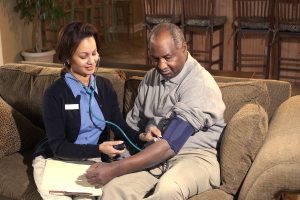Health benefits of UV by Marc Sorenson, Ed.D.
How important is UV?  A transcendentally important scientific paper, by Dr. AT Slominski and colleagues, has added significant information about UV (sunlight) for skin. In addition, it explains the intricate connection between sunlight and the immune, endocrine and central nervous systems.[1] The name of the research paper, published in the journal Endocrinology, is How ultraviolet light touches the brain and endocrine system through skin, and why. The authors begin the abstract by stating that “the skin is a self-regulating protective barrier organ that is empowered with sensory and computing capabilities to counteract the environmental stressors to maintain/restore disrupted cutaneous homeostasis.” In other words, the skin has the ability to take on what life deals it and maintain its equilibrium and balance. In addition, the skin communicates bidirectionally with the central nervous, endocrine and immune systems. Thus, it helps to maintain balance for all body systems.
A transcendentally important scientific paper, by Dr. AT Slominski and colleagues, has added significant information about UV (sunlight) for skin. In addition, it explains the intricate connection between sunlight and the immune, endocrine and central nervous systems.[1] The name of the research paper, published in the journal Endocrinology, is How ultraviolet light touches the brain and endocrine system through skin, and why. The authors begin the abstract by stating that “the skin is a self-regulating protective barrier organ that is empowered with sensory and computing capabilities to counteract the environmental stressors to maintain/restore disrupted cutaneous homeostasis.” In other words, the skin has the ability to take on what life deals it and maintain its equilibrium and balance. In addition, the skin communicates bidirectionally with the central nervous, endocrine and immune systems. Thus, it helps to maintain balance for all body systems.
How does UV work?
First of all, ultraviolet energy (UV and UVB light) triggers all of these marvelous processes. UV, of course is available from sunlight, sunbeds or sunlamps. Its electromagnetic energy, through the skin, converts to chemical, hormonal and neural signals. These signals promote positive effects on the immune system, the endocrine system and the brain. Furthermore, endorphins (opioid-like substances) are increased and immune-system proteins are mobilized; consequently, health improves with UV. And, sun exposure regulates the endocrine system, by way of exposure to the skin, to produce or diminish hormones as needed. Especially relevant is that these effects take place independently of vitamin D synthesis.
Health increases with UV due to the magnificent sun, and our magnificent skin. As a result of the above information, it seems like it would be a good idea to soak up some non-burning sun each day when available. And, when it is not, we should find another UV source. In our soon-to-be-published book, Embrace the Sun, we discuss many facts about the healthful effects sun exposure:
A few healthful effects of sun (UV) exposure
- prevents and reverses obesity
- Improves longevity by reducing the risk of death by 50% over 20 years
- reduces the risk of hip fracture by 90% when compared to sun avoidance
- prevents the risk of breast cancer by 90% when compared to sun avoidance
- reduces by 50% the risk of melanoma in outdoor workers compared with indoor workers
- increases heart and vascular strength
- dramatically improves mood
- reduces the risk of multiple sclerosis
- reduces risk of most internal cancers
- cures psoriasis and eczema
- reduces risk of nervous system disorders
- prevents memory loss
- prevents myopia
The above list is not surprising in view of this new research, nor is the list complete. UV has many more healthful effects, which I’m sure the authors of this research acknowledge. Hence, the scientists sum up their research in this manner: “Thus, UV touches the brain and central neuroendocrine system to reset body homeostasis. This invites multiple therapeutic applications of UV radiation, for example in the management of autoimmune and mood disorders, addiction, and obesity.”
In conclusion, this seem like more compelling evidence to safely embrace the sun, no?
[1] Slominski AT, Zmijewski MA, Plonka PM, Szaflarski JP, Paus R. How ultraviolet light touches the brain and endocrine system through skin, and why. Endocrinology. 2018 Mar 12. [Epub ahead of print]
Hypertension, or chronic high blood pressure, is determined by the amount of blood the heart pumps and the amount of resistance to blood flow in the arteries. The more blood the heart pumps and the tighter the arteries, the higher the blood pressure.[1] The top number on a blood-pressure measurement, stated in millimeters of mercury (mm/Hg), is called systolic pressure, and the lower number is called diastolic pressure. Hypertension is defined as having a blood pressure > 140/90 mm/Hg.  Thirty-one percent of US adults are hypertensive.[2] Hypertension can damage arterial walls and can eventually lead to an increased risk of death from heart disease, heart failure, and other arterial diseases. It is also associated to a higher risk of kidney disease, irregular heart rhythms, osteoporosis, cognitive dysfunction, painful intercourse and stroke.[3] Conventional textbook theory holds that blood pressure is regulated by the brain, blood vessels, or kidney, but recent evidence suggests it could be regulated in the skin, and sun exposure plays a role in controlling hypertension.[4]
Thirty-one percent of US adults are hypertensive.[2] Hypertension can damage arterial walls and can eventually lead to an increased risk of death from heart disease, heart failure, and other arterial diseases. It is also associated to a higher risk of kidney disease, irregular heart rhythms, osteoporosis, cognitive dysfunction, painful intercourse and stroke.[3] Conventional textbook theory holds that blood pressure is regulated by the brain, blood vessels, or kidney, but recent evidence suggests it could be regulated in the skin, and sun exposure plays a role in controlling hypertension.[4]
One of the earlier studies of hypertension and sun showed hypertension increased linearly at increasing distances from the equator.[5] One study of hypertensive subjects shows that blood pressure levels average 165/90 in winter but 134/74 in the summer, and both stroke and heart attack rates double in the winter.[6] Even in children, blood pressure is higher in winter than summer.[7] This, of course, is indicative of a protective role of sun exposure on hypertension.
UVB light treatments with sun lamps have also been shown to substantially lower blood pressure in 24 hours, and over six weeks to raise serum 25(OH)D levels of vitamin D by 162%, while lowering both systolic and diastolic pressure by six points.[8]
However, it is important to again mention that there is another important player in the relationship between hypertension and sun. Ultraviolet A (UVA) light (part of sunlight) stimulation of the skin causes the release of nitric oxide (NO) from pre-formed stores of NO in the skin. NO is a potent vasodilator, and when released into the arteries by UVA stimulation, causes increased blood flow and lowered blood pressure.[9], [10]
Safe sun exposure, along with plenty of vegetable and fruit consumption, may enable you to say goodbye to blood-pressure problems.
[1] Mayo Clinic Diseases and Conditions: High blood pressure (hypertension). http://www.mayoclinic.org/diseases-conditions/high-blood-pressure/basics/definition/con-20019580 (accessed January 5, 2016).
[2] Fields LE, Burt VL, Cutler JA, Hughes J, RoccellaEJ, Sorlie P. The burden of adult hypertension in the United States 1999–2000: a rising tide. Hypertension. 2004;44:398–404.
[3] Ann Pietrangelo. Healthline 2014 http://www.healthline.com/health/high-blood-pressure-hypertension/effect-on-body (accessed January 4, 2016).
[4] Johnson RS, Titze J, Weller R. Cutaneous control of blood pressure. Curr Opin Nephrol Hypertens. 2016;Jan25(1):11-5.
[5] Rostand SG. Ultraviolet light may contribute to geographic and racial blood pressure differences. Hypertension. 1997 Aug;30(2 Pt 1):150-6.
[6] Charach G, Rabinovich PD, Weintraub M. Seasonal changes in blood pressure and frequency of related complications in elderly Israeli patients with essential hypertension. Gerontology. 2004 Sep-Oct;50(5):315-21
[7] Polat M, Akil I, Yuksel H, Coskun S, Yilmaz D, Erguder I, Onag A. The Effect of seasonal changes on blood pressure and urine specific gravity in children living in Mediterranean climate. Med Sci Monit2006;12:CR186-90.
[8] Krae R, Bühring M, Hopfenmüller W, Holick MF, Sharma AM. Ultraviolet B and blood pressure. Lancet 1998;352:709-10.
[9] Liu D, Fernandez BO, Hamilton A, Lang NN, Gallagher JM, Newby DE, Feelisch M, Weller RB. UVA irradiation of human skin vasodilates arterial vasculature and lowers blood pressure independently of nitric oxide synthase. J Invest Dermatol. 2014 Jul;134(7):1839-46.
[10] D Liu, BO Fernandez, NN Lang, JM Gallagher, DE Newby, M Feelisch and RB Weller. UVA lowers blood pressure and vasodilates the systemic arterial vasculature by mobilization of cutaneous nitric oxide stores. Photobiology Abstract # 1247 May 2013.
